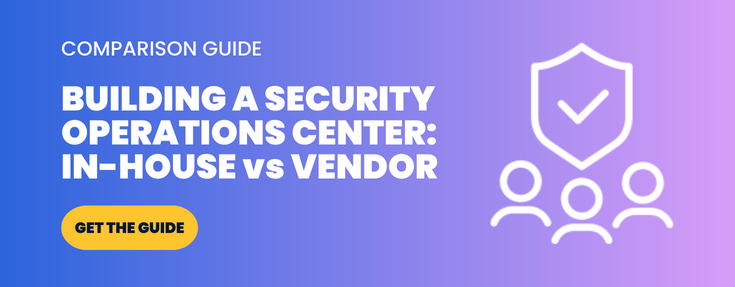Does my company need a SOC?

 By
Jason Miller
·
3 minute read
By
Jason Miller
·
3 minute read
A comprehensive and mature security solution isn’t just about log monitoring, or having the right SIEM tools to detect threats. Automated systems are all well and good, but eventually you’ll want a pair of expert eyes on your environment to make sure that everything looks as it should. And for that, you’ll want a Security Operations Center.
The top cybersecurity companies will use a SOC (Security Operations Center) to truly monitor and proactively protect an organization’s data systems. So we thought we’d write up a little something about the basics of a SOC, and what to look for when choosing a Security Operations Center provider.
What is a SOC (Security Operations Center) Anyway?
Imagine your favorite movie about the space program. (NASA. “Houston, we have a problem.” That sort of thing.)
Now, think about the control room that’s in those movies. Screens everywhere. Maps. Trajectories and data mapping and seasoned analysts watching for every move, every possible contingency, 24/7.
Take that control room and replace NASA with your company’s data systems.
Instead of monitoring the trajectory of a space shuttle, the experts are watching your data move through your system. Looking at access and authentications. At user behavior. Watching for any anomalous activity or potential threats that could hit your system and compromise your data, your employee’s data, or the data of your customers.
That control room is your Security Operations Center.

What Threats Can A Security Operations Center Detect?
While a SIEM software can meticulously monitor and detect tiny fluctuations of behavior within your logs, a security team is useful for more of the big picture threat detection and elimination stuff. Both are critical for a mature cybersecurity solution.
No matter how good your automated threat detection tools are, a tool is only as good as the expert that uses it. A SOC is where human eyes are on your system 24/7. The top security companies will get to know you and learn how your organization uses data to determine your company’s unique data fingerprint.
With that context in mind, a Security Operations Center provider can keep an eye out for the needle-in-a-haystack threats that an automated system might miss.
Security analysts can watch for activity that happens at unexpected times and unexpected places. Traffic that’s unusual behavior for a particular user. If someone odd tries to access your email, your data, your systems that you use daily.
By thoroughly understanding your context, and having broad and deep visibility into your system, your Security Operations Center can see deviations from the pattern and proactively see and stop threatening behavior before it becomes a major problem.
What Should I Look for in a SOC?
In one word: maturity.
Look for signs of proactive monitoring. A mature Security Operations Center is a proactive Security Operations Center. You’ll want to make sure that your provider is a bona-fide threat hunter.
Here are some red flags to watch out for when determining whether a team is mature enough to trust with your business:
Red Flag #1: They Wait For Alarms
If your provider proudly tells you that they will tell you when their systems send up a flag, or an alarm, that’s a red flag.
A mature team will be looking for problems before they see an alarm. If they’re waiting for alerts before addressing threats, it’s a sign that they aren’t being as vigilant as they could be… or that they don’t know what threats they should be looking for.
Red Flag #2: They Don’t Monitor Behavior Patterns For Warning Signs
If your security provider doesn’t keep an eye on your business 24/7, watching the normal day-to-day activity of your data network, they don’t have a baseline to understand when there is a deviation from that normal activity.
That means they have a much greater opportunity to miss something.
If they don’t know what warning signs to look for, they can’t be proactive.
Red Flag #3: They Charge Too Much (Or Too Little)
A mature security solution isn’t cheap. It shouldn’t be. The security of your company’s data, and your clients’ data, isn’t something to tackle on a budget.
That being said, a specialized and optimized Security Operations Center provider should be able to provide a deep level of security for much less money than it would take to bring that process entirely in-house.
A good service, depending on your specific needs, should run you the cost of a part-time to full-time employee. Any more than that, you’re probably being taken advantage of. Any less than that… you may not be getting all of the security services you think you’re paying for.
Red Flag #4: They Don’t Build A Personal Relationship With Your Company
In order to proactively seek threats, a Security Operations Center can’t wait around for an alert. This means they need to monitor your normal traffic patterns, and understand the context of your company’s unique data fingerprint.
They can’t build that deep understanding of your organization without taking the time to meet with you. Learn about you. Build a professional partnering relationship.
This means you should be getting regular phone calls. Questions. Have regular meetings scheduled to talk about goals, direction, compliance, and any changes you might make to your infrastructure.
If your security provider doesn’t care to do this, then chances are they aren’t a mature enough solution to take care of your business’ cybersecurity needs.
BitLyft Is Your Security Operations Center Solution
If you need a security operations center to be proactive threat hunters within your system, consider BitLyft Cybersecurity.
We install and monitor top of the line SIEM software, and we have 24/7 monitoring service with advanced network analytics, data forensics capability, and a defined threat remediation process.
And we always make time to get to know your company. To check in frequently. To gain a thorough understanding of your organization’s unique data fingerprint in order to protect and serve you better.
